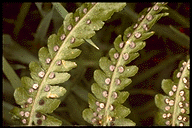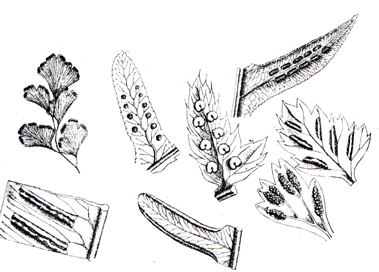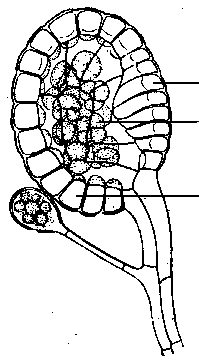| About 97% of living Pteridophytes are ferns. In fact, there are probably about 12,000
species of ferns in the world, most of these found in the tropics. Unlike the fern allies
which are a relic group, the ferns are highly successful and are virtually found in any
habitat flowering plants are found. |
|
| There are climbing ferns, aquatic ferns, tree ferns, filmy ferns with leaves just one cell thick, epiphytic ferns and, of course, ferns of a more conventional herbaceous habit. | |
Epiphytic Bird's nest fern |
These occupy a wide spectrum of habitats in the tropics and temperates from alpine through wet and dry zones [See Page (1979b) for details]. |
| In ferns, as for other pteridophytes, the sporophyte is the dominant
generation to the extent that this is the generation recognised as a fern. The gametophyte
is short-lived, a few mm in size and virtually hidden from view. |
Sporophyte |
Gametophyte |
Two features of ferns especially stand out ;-
| Large, typically pinnate, leaves - often termed fronds |  |
|
| Circinate vernation Term used to describe the protective coiling of young fern leaves into a spiral like a shepherd's crook or bishop's crozier or a fiddle head. | . |
| Ferns typically have a horizontal (often underground) stem or rhizome, swollen with food reserves, from which the leaves and roots arise. The leaves are typically compound and bear sporangia in clusters termed sori (sing. sorus). |
| A good, brief review of ferns can be found on the home page of the American Fern Society. A wide range of images of ferns can be seen in the University of Wisconsin's collection. Click here for more fern links. |
Fern spores are contained in sporangia which are borne on the leaf surface in clusters called sori.
 |
Sori come in all shapes, sizes and locations. They may appear as dots, dashes or lines on the leaf blade. They may occur tucked under the leaf edge as in the maidenhair ferns or in particular arrays on the leaf surface. |
| A sorus may be protected by an umbrella-like indusium, as shown below. | . |
| Vertical Section through fern leaf showing a sorus with indusium sporangium indusium |
|
| The sorus may simply be tucked protectively under the leaf edge (below). | . |
| V.S. Leaf of Adiantum Biodisc photomicrograph
|
| Some ferns, rather than having spores borne on all leaflets, have separate specialised spore-bearing (fertile) leaflets and separate photosynthetic, sterile leaflets. A good Caribbean example of this is the "flowering fern", Anemia adiantifolia, shown at right. |
| Spores are contained in sacs called sporangia. In many ferns, a crest
of dead cells termed the annulus undergoes hygroscopic
movements causing the sporangium to break open exposing the spores to air currents.The
sporangium breaks open in the region called the stomium. The opening of the sporangium has many parallels with the hygroscopic movement of elaters in liverworts. |
 |
stomium spores annulus |
| The annulus comprises dead water-filled cells and stretches about two-thirds of the
way around the sporangium. The walls of the cells of the annulus are thinner on the
outside than on the inside. Under dry conditions, water evaporates from the annulus distorting the outer
wall. This causes the annulus to peel back and the sporangium to open. As more water is lost, the tensile strength of water is overcome and air comes out of solution forming a bubble within each cell of the annulus. This results in a violent snapping back of the annulus, dislodging spores. |
| Fern spores are about 50 Ám in diameter. Dehiscence flicks them only a couple of cm from the leaf surface but this is enough. Air currents do the rest. One leaf of a small fern may shed 750,000 spores while a tree fern leaf may liberate 750 million spores! Fern spores travel far and wide and are very resistant to desiccation and uv light. They have been trapped at all altitudes aircraft can fly! Details in Page (1979a). |
| The fern spore once it lands somewhere moist (e.g. in the leaf litter) will germinate
to produce a filamentous gametophyte. This comprises photosynthetic cells full of
chloroplasts and a few colourless, thread-like rhizoids, as seen at right. Eventually this grows into a heart-shaped prothallus as shown below (A). |
 |
A. Mature gametophyte ar = archegonia B. Young sporophyte (b) growing out of gametophyte. |
| Club-shaped antheridia, full of sperm cells, and flask-shaped archegonia, each with an egg cell, form on the underside of the heart-shaped gametophyte. The multiflagellate antherozoids (sperm) swim in surface water to the archegonia, attracted by a chemical secreted by the egg. | The egg is fertilized and the diploid zygote grows into a new sporophyte (b in Fig B).
Initially, this is dependant on the gametophyte but it soon begins to photosynthesize and
soon the gametophyte withers and dies. |
| A key point to note about the ferns is that the sporophyte is limited by the gametophyte. The sporophyte can only grow in places where there is enough water for a gametophyte to develop and survive, even if this is only a few weeks a year! This gametophyte is really much like that of a leafy liverwort. |
| Would you
like to look at some sample questions on this part of the course? If so, click the button. |
![]() .
.
![]() C.M. Sean Carrington, April 10, 1998
C.M. Sean Carrington, April 10, 1998